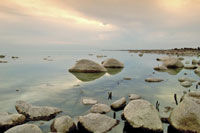
IT’S a country rich in architecture, history and politics and draws tourists from everywhere: over six million visitors have already visited Syria this year and the government has pumped in $940 million to upgrade its hotels, infrastructure, airports and tourism services. But more needs to be done.
TTN caught up with Syria’s Minister for Tourism, Saad Abdallah Al Qala, in an email interview, to find out more. Excerpts:
What’s the best time to visit?
Quite honestly, anytime. Syria is perfect all-year round. Arabs prefer the spring and summer, while autumn sees more Europeans, who come to see the cultural and religious sites such as Palmyra, Aleppo Citadel and Basra and the old towns in Damascus and Aleppo. In the winter, the ski slopes are a big draw. Last year tourist numbers, excluding Syrian expatriates and one-day visitors touched 3.4 million – an increase of 15 per cent.
What are the major tourist markets for Syria and how does the Mideast market fare?
At least 74 per cent of tourists come from Arab countries with a relatively high accommodation rate – 10 days. This has contributed to a lot of stability to the tourism industry. Syria is, for many Arab visitors, especially from the Gulf, the first country of choice for a vacation. The rest come from Islamic countries, particularly Turkey (13 per cent) and Iran (6 per cent), and visitors from Europe and the US account for 13 per cent, or about an annual six per cent growth rate. Germany and France are the major traditional European markets, but 2005 statistics show a great increase in Russian and Spanish tourists. The other segment of tourists is the Syrian expatriates around the world, who constitute 24 per cent of the total, with one million visits every year. With over 16 million expats, they are a constant focus of our promotional efforts.
What is the focus of tourism in Syria?
We’ve exerted every effort to promote the country and this has paid rich dividends. The rise in visitors has necessitated more financial investments into the sector, demarcation of more land for tourism projects and the upgrading of infrastructure and services all around. New regulations have also been drawn up to raise the flow of investment into the sector. Consequently, over the last three years, investments into this key sector have been gone up from $100 million in 2003 to $940 million in 2005. The money being ploughed in is being distributed into all areas, including border points, airports, archaeological sites and markets.
What are your ministry’s marketing plans?
According to surveys at airports and border points, 40 per cent of departing tourists said they visited Syria on a friend’s recommendation and 37 per cent after read-ing an article or watching a documentary on Syria. There is a lot going for Syria, the warmth of its people, its hospitality, the feeling of security and the high quality of tourism services. We are working on further developing the sector and one of the most important ways of doing it is to promote the country and provide services of international standard. Towards this, the ministry has invited press and travel agents to the country – in 2002, about 66 tourist agents and media were invited, but last year the number rose to 516.
The number of international exhibitions too has risen from 15 in 2002 to 30 in 2005. We are also working on restructuring the market in terms of quality and distri-bution, and have extensive promotional campaigns. We’re now providing an outside representation of the ministry in the main tourist exporting countries.
We’re also targeting new markets like Japan and China, which will become the world’s biggest tourist exporter within 10 years. Last year, Syria was given an Approved Destination Status for Chinese tourism and the Chinese market is now being studied closely and plans are being drawn to further stimulate our marketing and promotion blitz in China.
Are there plans for more tourist investment projects in Syria?
Syria is encouraging the private sector to enter the tourism sector and is offering all the facilities and exemptions needed to create an attractive investment environment for both local, Arab and foreign investments. Some of the new projects include the $210 million Kiwan project in Damascus by the Al Khourafi group and Intercontinental management; the $400 million Intrados project in Tartous by British and Syrian partners; the $80 million East Meridien project in Aleppo; the, $137 million Tarek Bin Ziad BaITack project in Aleppo, by a group of Arab and Syrian investors and the Intercontinental management.
Finally what steps has Syria taken to enhance security and stability?
Tourists can be assured of a smooth entry, and everything is being done to spread this word around through fam trips for the media and travels agents who come here and see for themselves the security and stability prevalent in the country. They, in turn, tell their readers and clients what they have seen and experienced. The ministry has also ensured that entry at border points and airports are safe and smooth for tourists. For Arabs, an entry visa is no longer required. For other foreigners visiting Syria, entry visas can also be obtained at the airport or border points if the visitor has come through a tourism agency in his country and the agency has a representative in Syria.
